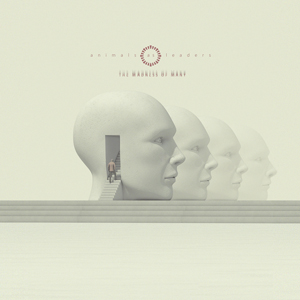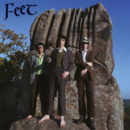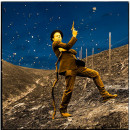Have you ever wondered what it would be like to step inside the mind of a brilliant musician?
Sit back with a pair of headphones, try to relax, and enter into The Madness of Many, the latest album from instrumental progressive metal band Animals as Leaders.
As Javier Reyes, the band’s guitarist and also the man who mixed this album, their fourth, tells their label Sumerian Records, “What you’re hearing is the madness of the band, what happens in our heads, and what it sounds like when you put it all together. For us, that’s the sound of the new album. It’s simply the madness of these three individuals. We’re trying to create something that only we can do.”
Just don’t get too comfortable. As it turns out, being welcomed into the mind of a group of highly complex musicians is less like relaxing on a plush sofa and more like trekking through a long, confusing maze. Enchanting at one turn and alarming at the next, you’re stuck wondering if you’re ever going to make it out to the other side. (The other side is where you finally “get it” after immersing yourself in the fifth or sixth listen). The journey is a constant battle between beauty and horror that leaves the listener wondering if the two concepts aren’t actually one in the same.
Fronted by Tosin Abasi, a man with a rapid-fire mastery of his eight-string guitar so incomprehensible he’s been accused of replacing his mere mortal fingers with those of a robot, Animals as Leaders doesn’t exactly fall under “easy listening.” It’s certainly not because of intense, growling vocals—as an instrumental metal band, they don’t have any. Instead, the band is known for compositional complexity: mind-boggling hops across disparate genres, varying time signatures that jolt the listener out of a rhythm as soon as one falls into it, and arduous breakdowns that bellow deep into the pits of the inner eardrum.
The Madness of Many might be their most puzzling and impenetrable work yet. Whereas songs like “Tooth and Claw” on previous albums rewarded the studious listener with the respite of the occasional opening up into a catchy guitar melody, the latest release offers almost no rest, challenging fans to push through the hard listening, to find harmony in dissonance and pleasure in disconcerting arrangements. Where older songs like “CAFO” balanced their extreme density with ample headbanging opportunities, this new album instead brings in in soft acoustic sonatas like “The Brain Dance” that seem far more fit for a ballerina than even the most refined of metalheads.
Somehow, Animals as Leaders managed to push the boundaries of genre affiliation.
Somehow, Animals as Leaders managed to push the boundaries of genre affiliation as well. Animals as Leaders has always drawn heavily on experimental jazz, a notoriously inaccessible genre. A few tracks on The Joy of Motion, their second-to-latest release, border on being full-blown modern jazz with a metal influence. But their latest album reaches even further, bringing in everything from classical music in “Apeirophobia” to world music reminiscent of Hindu chants in the album’s first single, “Arithmophobia.”
Long-time fans of Animals as Leaders, who formed in 2007, always knew that they were incredibly talented, between their second-to-last album miraculously hitting #24 on the Billboard top 200 and Tosin Abasi landing the cover of Guitar World twice. But The Madness of Many unlocks a depth of musical talent they’ve never shown off before, perhaps because they hadn’t found it until now.
The Madness of Many is the first time they’ve self-produced, with Javier Reyes doing all the mixing. According to the band, that change alone has made the album their most collaborative effort yet – when you don’t have a coach to guide your team, you really have to work together. You can hear this in all the different personal styles that come forth in this album, and somehow, they meld together perfectly, producing an album at once wildly eclectic and effortlessly smooth.
I’d call it “musican’s music” if I didn’t wholeheartedly disagree with the premise that certain types of music are too complex to be enjoyed by us regular folk.
The Madness of Many is hard to swallow because it’s so unrelenting in its display of musical potency and undiluted originality. But to those who are willing to give their listen a little more effort: when you make it to the other side of the maze, the view will be astounding.
We give this album 7,900 out of 10,000 Rawckus Throwing Stars.













